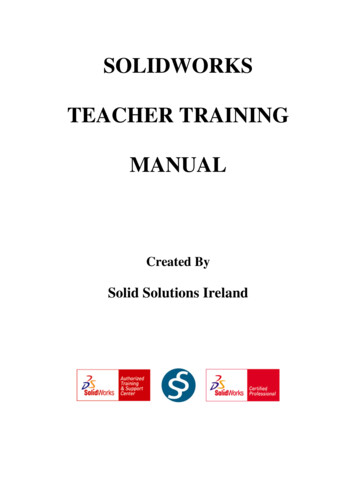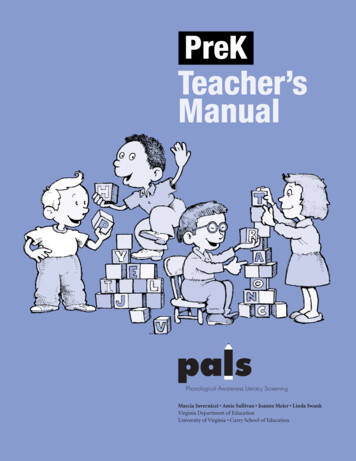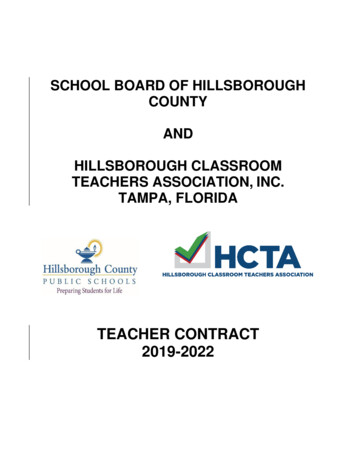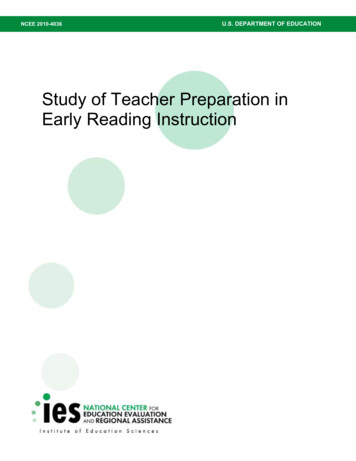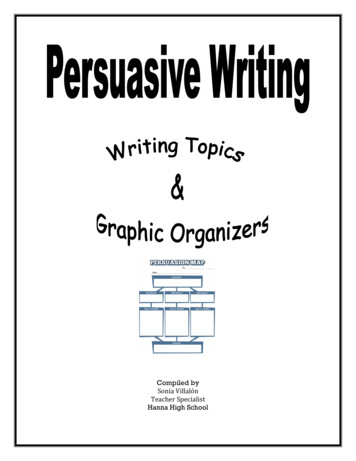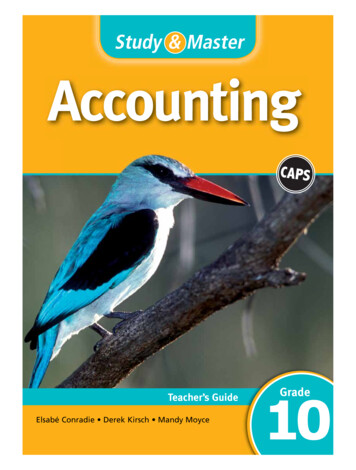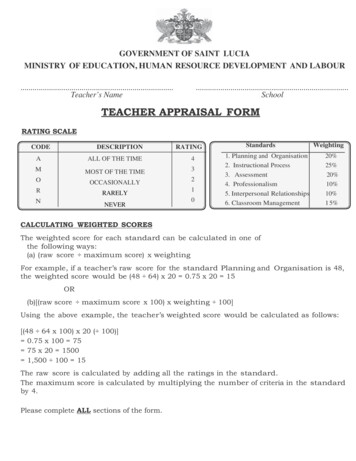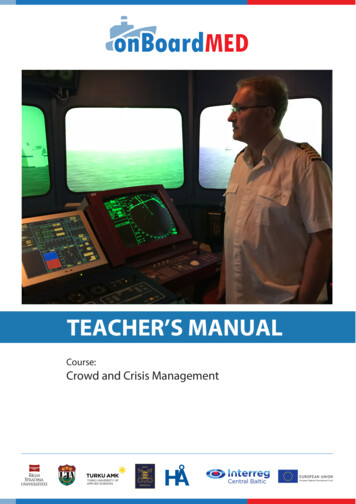
Transcription
TEACHER’S MANUALCourse:Crowd and Crisis ManagementEUROPEAN UNIONEuropean Regional Development Fund
Crowd and Crisis Management 2 ECTS (54 h)Teacher’s manualThe purpose of the teacher’s manual is to assist teachers in organizing and introducing training courses. It isnot the intention of teacher’s manual to provide teachers with a rigidteaching package which they are expected to "follow blindly", because national educational systems,groups size and the cultural backgrounds of trainees in maritime subjects vary considerably from country tocountry. The teacher can choose suitable parts for target group and can even make changes that is neededto achieve the learning outcomes.The teacher’s manual has been designed to give ideas how to you use material developed in the OnBoardMed –project. Teacher’s manuals content is: objectives, content, target group and student’s amount,implementation and learning methods, assessment, learning process (summary) and tips for the teacher.Crowd and Crisis ManagementCrowd management training and, Crisis and human behaviour training is described in Standards of Training,Certification and Watchkeeping (STCW) 2017. Courses are referred to in chapter V, regulation V/2paragraph 7 and 8 (STCW-convention) and in sections A-V/2 paragraph 3 and 4 (STCW-code). Specificationfor minimum standard of competence in crowd management training is listed in table A-V/2-1 and for crisismanagement training in table A-V/2-2.A general description of the concept crisis could be any event that is, or is expected to lead to, an unstableand dangerous situation affecting an individual, group, community, or whole society. Good CrisisManagement starts with a risk analysis followed by development of contingency plans to prevent risks.When contingency plans are in place there is a need for training and exercise to prepare crew members andto scrutinize the procedures in order to improve them. Then, if an accident occurs, the crew should beprepared and well trained to manage the situation. Finally, good Crisis Management should establish apreparedness to manage the aftermath.OBJECTIVES:From STCW table A-V/2-1; Passenger ship crowd management training: Contribute to the implementation of shipboard emergency plans and procedures to muster andevacuate passengersAssist passengers en route to muster and embarkation stationsFrom STCW table A-V/2-2; Passenger ship crisis management and human behaviour: Organize shipboard emergency proceduresOptimize the use of resources
Control response to emergenciesControl passengers and other personnel during emergency situationsEstablish and maintain effective communicationsCourse topic not included in STCW: Media management in crisisFor more specific information about competence and assessment, see STCW-tables below.Table A-V/2-1Specification of minimum standard of competence in passenger ship crowd management trainingColumn 1Column 2Column 3Column 4CompetenceKnowledge,understanding andproficiencyMethods fordemonstratingcompetenceCriteria forevaluatingcompetenceContribute to theimplementation ofshipboardemergency plansand procedures tomuster and evacuatepassengersKnowledge of theshipboard emergencyplans, instructions andprocedures related tothe management andevacuation ofpassengersAssessment ofevidence obtainedfrom trainingand/or instructionActions taken in caseof an emergency areappropriate andcomply withestablishedproceduresAssessment ofevidence obtainedfrom practicaltraining and/orinstructionActions taken conformwith emergency plans,instructions andprocedures Informationgiven to individuals,emergency responseteams and passengersis accurate, relevantand timelyKnowledge ofapplicable crowdmanagementtechniques andrelevant equipment tobe used to assistpassengers in anemergency situationKnowledge of musterlists and emergencyinstructionsAssist passengersen route to musterand embarkationstationsAbility to give clearreassuring ordersAbility to managepassengers incorridors, staircasesand passagewaysUnderstanding theimportance of andhaving the ability tomaintain escaperoutes clear of
obstructionsKnowledge of methodsavailable forevacuation of disabledpersons and personsneeding specialassistanceKnowledge of methodsof searchingpassengeraccommodation andpublic spacesAbility to disembarkpassengers, withspecial attention todisabled persons andpersons needingassistanceImportance of effectivemustering procedures,including:.1 the importance ofkeeping order;.2 the ability to useprocedures forreducing and avoidingpanic;.3 the ability to use,where appropriate,passenger lists forevacuation counts;.4 the importance ofpassengers beingsuitably clothed as faras possible whenmustering; and.5 the ability to checkthat the passengershave donned their lifejackets correctly.
Table A-V/2-2Specification of minimum standard of competence in passenger ship crisis management and human behaviourColumn 1Column 2Column 3Column 4CompetenceKnowledge,understanding andproficiencyMethods fordemonstratingcompetenceCriteria forevaluatingcompetenceAssessment ofevidence obtainedfrom approvedtraining, exerciseswith one or moreprepared emergencyplans and practicaldemonstrationThe shipboardemergencyprocedures ensurea state of readinessto respond toemergencysituationsAssessment ofevidence obtainedfrom approvedtraining, exerciseswith one or moreprepared emergencyplans and practicaldemonstrationContingency plansoptimize the use ofavailable edge of:.1 the general design andlayout of the ship.2 safety regulations.3 emergency plans andproceduresThe importance of theprinciples for thedevelopment of shipspecific emergencyprocedures, including:.1 the need for preplanning and drills ofshipboard emergencyprocedures.2 the need for allpersonnel to be aware ofand adhere to pre-plannedemergency procedures ascarefully as possible in theevent of an emergencysituationOptimize the useof resourcesAbility to optimize the useof resources, taking intoaccount:.1 the possibility thatresources available in anemergency may be limited.2 the need to make fulluse of personnel andequipment immediatelyavailable and, if necessary,to improviseAbility to organize realisticdrills to maintain a state ofreadiness, taking intoaccount lessons learntfrom previous accidentsinvolving passenger ships;Allocation of tasksand responsibilitiesreflects the knowncompetence ofindividualsRoles andresponsibilities ofteams andindividuals areclearly defined
debriefing after drillsControl responseto emergenciesAbility to make an initialassessment and providean effective response toemergency situations inaccordance withestablished emergencyproceduresLeadership skillsAssessment ofevidence obtainedfrom approvedtraining, practicaldemonstration andshipboard trainingand drills ofemergencyproceduresProcedures andactions are inaccordance withestablishedprinciples and plansfor crisismanagement onboardObjectives andstrategy areappropriate to thenature of theemergency, takeaccount ofcontingencies andmake optimum useof availableresourcesAbility to lead and directothers in emergencysituations, including theneed:.1 to set an example duringemergency situations.2 to focus decisionmaking, given the need toact quickly in anemergencyActions of crewmembers contributeto maintaining orderand control.3 to motivate, encourageand reassure passengersand other personnelStress handlingAbility to identify thedevelopment of symptomsof excessive personalstress and those of othermembers of the ship'semergency teamUnderstanding that stressgenerated by emergencysituations can affect theperformance of individualsand their ability to act oninstructions and followproceduresControlpassengers andother personnelduring emergencysituationsHuman behaviour andresponsesAbility to controlpassengers and otherpersonnel in emergencysituations, including:.1 awareness of thegeneral reaction patternsof passengers and otherpersonnel in emergencysituations, including theAssessment ofevidence obtainedfrom approvedtraining, practicaldemonstration andshipboard trainingand drills ofemergencyproceduresActions of crewmembers contributeto maintaining orderand control
possibility that:.1.1 generally it takessome time before peopleaccept the fact that there isan emergency situation.1.2 some people maypanic and not behave witha normal level ofrationality, that their abilityto comprehend may beimpaired and they may notbe as responsive toinstructions as innonemergency situations.2 awareness thatpassengers and otherpersonnel may, inter alia:.2.1 start looking forrelatives, friends and/ortheir belongings as a firstreaction when somethinggoes wrong.2.2 seek safety in theircabins or in other placeson board where they thinkthat they can escapedanger.2.3 tend to move to theupper side when the ship islisting.3 appreciation of thepossible problem of panicresulting from separatingfamiliesEstablish andmaintain effectivecommunicationsAbility to establish andmaintain effectivecommunications, including:.1 the importance of clearand concise instructionsand reports.2 the need to encouragean exchange of informationwith, and feedback from,passengers and otherpersonnelAbility to provide relevantinformation to passengersand other personnel duringan emergency situation, toAssessment ofevidence obtainedfrom approvedtraining, exercisesand practicaldemonstrationInformation from allavailable sources isobtained, evaluatedand confirmed asquickly as possibleand reviewedthroughout theemergencyInformation given toindividuals,emergencyresponse teamsand passengers isaccurate, relevantand timelyInformation keeps
keep them apprised of theoverall situation and tocommunicate any actionrequired of them, takinginto account:passengersinformed as to thenature of theemergency and theactions required ofthem.1 the language orlanguages appropriate tothe principal nationalities ofpassengers and otherpersonnel carried on theparticular route.2 the possible need tocommunicate during anemergency by some othermeans, such as bydemonstration, or by handsignals or calling attentionto the location ofinstructions, musterstations, life-savingdevices or evacuationroutes, when oralcommunication isimpractical.3 the language in whichemergencyannouncements may bebroadcast during anemergency or drill toconvey critical guidance topassengers and tofacilitate crew members inassisting passengersTARGET GROUP AND STUDENT AMOUNT:Maritime students and/or external participants. Ideal group size 12 participantsIMPLEMENTATION AND LEARNING METHODS lectureslow fidelity simulatione-learningexercisehigh fidelity simulationASSESSMENTContinuous assessment during the course with regard to activity in participation
SUMMARYFrom this summary you can, as a teacher, easily choose what learning subjects and material you want touse with your students (depends on the target group and the group size).CONTENTPre-studies- Activity 1: Keyterms andabbreviationsTIME3-5 h-Activity 2: List ofMaritimedisasters4-6 h-Activity 3:Describe an ownexperience1-3 h-Introduction,2hcourse scheduleand presentation(of lecturers andparticipants)-Why crisismanagementIntroduction tocrisis anddisasterpsychologyOptimizingresources andcontrol responseto emergency1hCrisiscommunication---LEARNING METHODS and MATERIALASSESSMENTPre-work with distance learning.Multiple choice questionnaire.References to relevant extractedmaterials (Internet can be used)Continuousassessment duringthe course withregard to activity inparticipationPre-work with distance learning. Theparticipant gets a list containingmaritime disasters and have to findinformation about them from Internet.Pre-work with distance learning. Theparticipant writes down an ownexperience of stress. This is arecommended but voluntary part ofthe pre-work. Should be handled withcare.2hPresentation of course program (ppt 1)Show film OceanosPresentation of participants. Theparticipants are asked to share an ownexperience together with theirpresentation. These could be examplesin the lectures later.Presentation motivating crisismanagement (ppt 2)Basics. Lecture (ppt 3)3hLecture and group work. (ppt 4)2-4 hPresentation (ppt 5). Could alsocontain a group work where the
students/participants record a PAannouncement in their smartphonesand these are then played by theinstructor and discussed in class.Specific attention should be focusedon trigger-words.Another group work: “Broken Phone”(a message is passed on from oneperson to another in a chain ofstudents / Closed Loop.Lecture. (ppt 6)-Mediamanagement2h-Rear-viewmirrorCognition andperceptionStress reactions.BasicsGroup workManagingindividualreactions h-Exercise5h-Rear-view mirror 1 hLooking back on previous lessons.(Control of competence/Assessment)-Debriefing ofexerciseTechnical reviewof exerciseLeadership anddecision makingunder stressInstructor conducts a full debriefingwith students/participantsInstructor reviews the structure andcontents of the exerciseLecture. (ppt 12)---2hLooking back on previous lessons.(Control of competence/Assessment)Lecture (ppt 7)2hLecture (ppt 8)1h2hHandling of people under stressLecture (ppt 9)2hLecture (ppt 10)Group work (Questions)Lecture (ppt 11)2h3h1h2h
-Summary andevaluation2hTIPS FOR THE TEACHER:Pre-work 1 could be used as pre-work or as final assessment of the non-technical skills in the course.The purpose of pre-work 2 is two-fold:The student/participant gets in to the crisis-thinking as the suggested disasters clearly show that disastershappen and they can also analyze why disasters happen.The pre-task 2 is a good background for the part of Optimizing resources and Control response toemergenciesFor pre-task 3 “Describe an own experience” it is important to explain to students/externals that theyshould not describe very traumatic experiences. There is no need for that and such events could be difficultto handle for the instructor. The task is voluntary but it has many advantages: The experiences coul
1 h Presentation motivating crisis management (ppt 2) - Introduction to crisis and disaster psychology 2 h Basics. Lecture (ppt 3) - Optimizing resources and control response to emergency 3 h Lecture and group work. (ppt 4) - Crisis communication 2-4 h Presentation (ppt 5). Could also contain a group work where the . students/participants record a PA-announcement in their smartphones and these .
